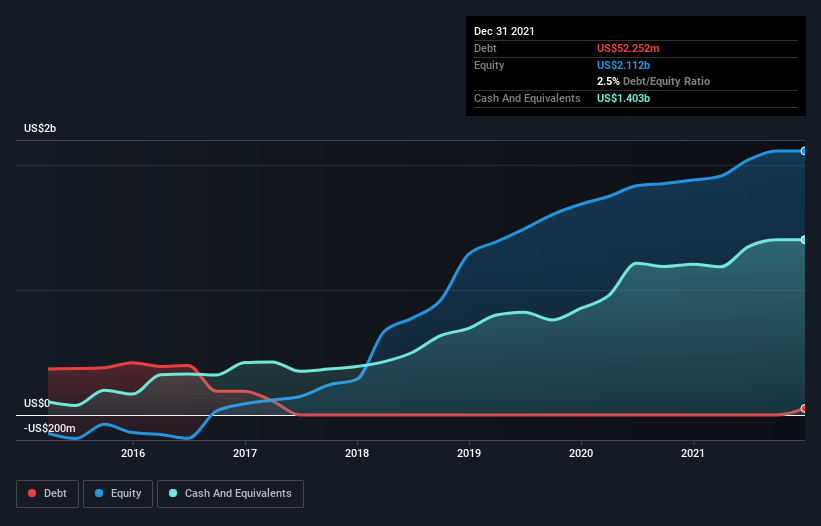Does Exelixis (NASDAQ:EXEL) Have A Healthy Balance Sheet?
David Iben put it well when he said, 'Volatility is not a risk we care about. What we care about is avoiding the permanent loss of capital.' It's only natural to consider a company's balance sheet when you examine how risky it is, since debt is often involved when a business collapses. As with many other companies Exelixis, Inc. (NASDAQ:EXEL) makes use of debt. But should shareholders be worried about its use of debt?
What Risk Does Debt Bring?
Generally speaking, debt only becomes a real problem when a company can't easily pay it off, either by raising capital or with its own cash flow. Part and parcel of capitalism is the process of 'creative destruction' where failed businesses are mercilessly liquidated by their bankers. However, a more usual (but still expensive) situation is where a company must dilute shareholders at a cheap share price simply to get debt under control. By replacing dilution, though, debt can be an extremely good tool for businesses that need capital to invest in growth at high rates of return. The first thing to do when considering how much debt a business uses is to look at its cash and debt together.
Check out our latest analysis for Exelixis
How Much Debt Does Exelixis Carry?
As you can see below, at the end of September 2021, Exelixis had US$52.3m of debt, up from none a year ago. Click the image for more detail. However, its balance sheet shows it holds US$1.40b in cash, so it actually has US$1.35b net cash.
A Look At Exelixis' Liabilities
The latest balance sheet data shows that Exelixis had liabilities of US$269.5m due within a year, and liabilities of US$65.8m falling due after that. Offsetting these obligations, it had cash of US$1.40b as well as receivables valued at US$182.1m due within 12 months. So it can boast US$1.25b more liquid assets than total liabilities.
This surplus suggests that Exelixis is using debt in a way that is appears to be both safe and conservative. Given it has easily adequate short term liquidity, we don't think it will have any issues with its lenders. Simply put, the fact that Exelixis has more cash than debt is arguably a good indication that it can manage its debt safely.
Even more impressive was the fact that Exelixis grew its EBIT by 154% over twelve months. If maintained that growth will make the debt even more manageable in the years ahead. There's no doubt that we learn most about debt from the balance sheet. But ultimately the future profitability of the business will decide if Exelixis can strengthen its balance sheet over time. So if you want to see what the professionals think, you might find this free report on analyst profit forecasts to be interesting.
Finally, a business needs free cash flow to pay off debt; accounting profits just don't cut it. Exelixis may have net cash on the balance sheet, but it is still interesting to look at how well the business converts its earnings before interest and tax (EBIT) to free cash flow, because that will influence both its need for, and its capacity to manage debt. Over the last three years, Exelixis actually produced more free cash flow than EBIT. There's nothing better than incoming cash when it comes to staying in your lenders' good graces.
Summing up
While it is always sensible to investigate a company's debt, in this case Exelixis has US$1.35b in net cash and a decent-looking balance sheet. The cherry on top was that in converted 126% of that EBIT to free cash flow, bringing in US$275m. When it comes to Exelixis's debt, we sufficiently relaxed that our mind turns to the jacuzzi. When analysing debt levels, the balance sheet is the obvious place to start. However, not all investment risk resides within the balance sheet - far from it. For instance, we've identified 1 warning sign for Exelixis that you should be aware of.
At the end of the day, it's often better to focus on companies that are free from net debt. You can access our special list of such companies (all with a track record of profit growth). It's free.
Have feedback on this article? Concerned about the content? Get in touch with us directly. Alternatively, email editorial-team (at) simplywallst.com.
This article by Simply Wall St is general in nature. We provide commentary based on historical data and analyst forecasts only using an unbiased methodology and our articles are not intended to be financial advice. It does not constitute a recommendation to buy or sell any stock, and does not take account of your objectives, or your financial situation. We aim to bring you long-term focused analysis driven by fundamental data. Note that our analysis may not factor in the latest price-sensitive company announcements or qualitative material. Simply Wall St has no position in any stocks mentioned.

